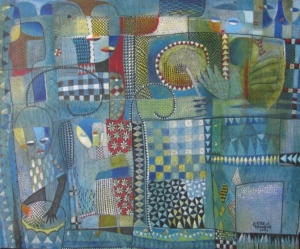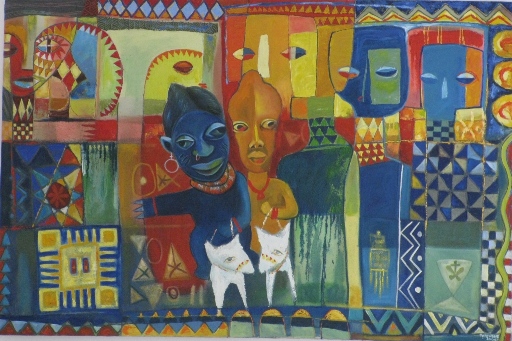TOLA WEWE, NIKE OKUNDAYE AND THE EMERGENCE OF A THIRD ARTIST: “NIKE & WEWE”
Most of us share the prevalent image of the artist as that of an independent, stand-alone figure, expressing her singular creativity through the production of artworks. This stereotypical image is deeply entrenched in the way artists are presented in the media and in the way originality and authenticity are valued in the art markets. Looking at the extensive collection of works signed jointly by Nike & Wewe in the exhibition currently showing at the new Nike Gallery in Lekki some questions about this way of art production came to my mind. And the reason is that collaborative art changes our accepted view of the figure of the artist, transforming individual artistic identity into a new merged identity.

Beyond the indisputable quality of the canvases on display, there are issues of authorship, identity and authenticity that can’t be put aside. As if to confirm my initial feeling, I heard somebody at the opening of the exhibition: OK, it is alright to sign the works jointly, but actually, who is the real author of this work? Nike Okundaye or Tola Wewe? I guess the answer should have been: the author of these works is neither Nike nor Wewe, but a “third artist”: “Nike & Wewe”
If the negotiations between the “conceptual” and the “factual” aspects of art creation, between the idea and its execution, are generally rich in possibilities, in this case, they are central to the interpretation and analysis of the works on display. But first, a few thoughts about collaboration in the arts.

There are many human activities that require the input of several people whether simultaneously or consecutively. A building may start with a few ideas in the mind of an architect, but to move from conceptual sketches to a habitable physical structure there is need for the contribution of several other professionals. Some art forms are collaborative by nature: film or video art, dance, theatre, musical performance, architecture, performance art. They require the involvement of several individuals. They are essentially collaborative.
Both, in the West and in Nigeria, there is a long tradition of art workshops producing art objects through a collaborative effort. In the large studios of European artists of the past it was not only the “master” that left his input on the canvases. Other less known painters and assistants applied their skills to the work eventually assigned to a single artist. And this was not a way of “corporate deceit” but a way of producing art.Rembrandt or Raphael did not have any problem in appending their names to works that had been produced in their studios and on which more than one artist had worked. In these cases, the name, personality and artistic genius of the “master” was so great as to eclipse his assistants. There is no doubt that the final work was Rembrandt’s.

It is only in the past 40 years that collaboration in the visual arts has emerged as an “issue” and as an “ideological position”. For instance, Warhol and Basquiat painted several canvases together. Warhol would use a projector to outline symbols, text, adverts, logos on the canvas and Basquiat would complete the work adding his highly expressive, grafitti-like inscriptions around –sometimes, on top of- Warhols’ drawings. No need to be a “connoisseur” to distinguish Warhol’s input from that of Basquiat. In recent history there are quite a few examples of two artists linked by family ties and working as a single practice: Christo and Jean-Claude (she died a few days ago), Ed and Nancy Kienholz, Robert and Sonia Delauney, Mark Dunhill and Tamiko O’Brien, the Wilson sisters come to mind, but in most cases the reason for the collaboration comes from a different source than physical proximity and the sharing of the a working space. There are joint practices that have become such not as an acknowledgement of a reality but as a result of a deliberate decision to produce artworks by adding the inputs of two artists. …

In the last few years the vanguards seem to have moved gradually from being centred on the art object to focusing the attention on context and then to being concerned about the art production process through forms of collaborative or community art: it is the artist (or frequently, the art group) as a socially engaged activist. This is not the case with Nike and Wewe. They do not aim at posing a critical challenge to authorship issues. They did not set out to confront accepted theories of art as self-expression or to engage the community. Unlike most collaborative art practices in Europe after the 1970’s, the artistic collaboration of Wewe and Nike is not intrinsic to their joint work. Their dual signature approach is not a strategy to advance a new understanding of artistic identity. They work within an established understanding of art practice. It is just that they “happen to work together” and divide their work because this makes things easier for both.
In the collaborative art practice of Tola Wewe and Nike Okundaye there is no much loss of personal identities. What has been called a “third artist” seems to have emerged, an artistic persona without reality beyond their jointly executed works. This third artist “Nike & Wewe” appears with identifiable characteristics and a separate artistic personality. The new artist (meta-artist) “appropriates” the working styles and mannerisms of both artists and produces works that are, in my opinion, greater than the addition of the two component elements. The canvasses of “Nike & Wewe” possess the particularity, differentiation and uniqueness proper to an individual artist. In many ways, these works are richer than those produced by Wewe or Nike separately. One of the reasons for the success of their collaborative practice is that each artist respects the boundaries of the other one.

In most instances collaborative painting has been done by two or more artists (or one artist and his/her apprentices) working as one and working at the same time. In the collaborative works of Tola Wewe and Nike the respective contributions are mainly sequential: Tola first, Nike second. I understand that the process consists of two discreet steps: first Tola conceives the compositional aspects of the painting, draws the main lines and base colours, fills some areas of the work and then Nike undertakes the infilling of the rest. Each one plays on his/her strengths. The meticulous, delicate ink pen work of Nike does very well on the habitual outlines and figures of Wewe. Surprisingly, the result is not a mishmash and their joint works are consistent with their previous individual productions.
Another interesting aspect is that the joint works are produced through a process that does not involve shared research or preliminary discussions on the work, regular interaction between the artists during the production of the work. Tola Wewe leaves freedom to Nike to add, cover or fill-in whatever area of the canvass she decides. More than collaboration it could be called shared production, because they collaborate but, generally, they do not work together. The collaboration benefits both: the compositional strengths of Wewe are enhanced with the detailed draftsmanship of Nike. It is fortunate that works produced jointly by the two artists are displayed in this exhibition along those produced by each of the artists separately. Things become clearer when a join work is shown between works done individually.
It is surprising that despite the fact that the first joint works of Wewe and Nike go back some years it is only now that an exhibition of the joint works is organized. This is a good development. I welcome the “third artist” in the exhibition: “Nike & Wewe”.

